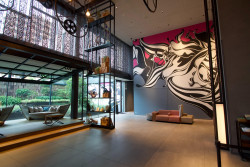
September 3, 2009
Dances With Wolves
Tomoko Konoike's shamanistic art offers hope to a confused Japan
By Metropolis
Originally published on metropolis.co.jp on September 2009

Shira—Spirit from the Wild (detail), 2009, Japanese ink, shell powder, gold leaf on Kumohada-mashi paper, 1.82 x 16.32m ©KONOIKE Tomoko, Courtesy: Mizuma Art Gallery
A country with strong aesthetic traditions like Japan never has a shortage of talented artists, even if most of them simply fall by the wayside and are forgotten. The few who succeed usually do so because their work strikes a deep chord with the spirit of the age—like that of Tomoko Konoike. The youthful-looking 49-year-old is widely seen as one of the brightest stars in a rising constellation of Japanese artists that is poised to make a strong impact on the international art scene.
A graduate of Tokyo’s National University of Fine Arts and Music, Konoike has all the patient skill and refined technique of others who have passed through that institution. But in addition her art is infused with a dreamlike, hypnotic quality that transcends normal artistic effect and resonates more deeply and widely with the soul of contemporary Japan.

Installation view, The Planet is Covered by Silvery Sleep, Mizuma Art Gallery, Tokyo, 2006Photo by Monty DiPietro
Not that Konoike would know anything about this. When I catch up with her at Tokyo Opera City Art Gallery, where she is busily preparing her major solo exhibition “Tomoko Konoike: Inter-Traveller (Playing with Myth),” she claims to be an entirely intuitive artist with little conscious awareness of why she paints the way she does.
“I don’t have any concepts or message,” she says. “I feel more like something is coming through me. I’m like a vessel and there is something behind me.”
As she talks, she reaches behind herself with her right hand, grabbing the air to demonstrate.
“It’s something over here. I can feel it; I can even hold its tail. I don’t know what it looks like, but maybe if I paint it, then I’ll realize this is it or this is not it.”
It’s no surprise that Konoike refers to her mysterious muse as having a tail of some sort, as her works abound with tailed, winged, and horned creatures, as well as strange hybrids of these elements. Among the Akita-born artist’s regular motifs are bees, antlers, dragonfly wings, human legs and daggers. But the ones that stand out the strongest are her wolves.
With their sense of slavering menace, these beasts are everywhere in Konoike’s art, from the works displayed at the recent Neoteny group exhibition at the Ueno Royal Museum to several pieces at her latest solo show, including Shira—Spirit from the Wild (2009), a series which includes a pack of howling wolves with human-like rear legs painted on fusuma (paper doors). These images have all the artistic precision and finesse of the most delicate nihonga art, but with a wild, feral energy that creates a fascinating counterpoint.
In the past, Konoike’s famous wolves have led interpreters of her work to jump to the wrong conclusions.
“Several years ago a journalist from The New York Times and some from Europe said the wolves represented some kind of scary experience,” she says with a laugh. “They thought I might have had some sort of bad or cruel experience, or some family trauma or sexual abuse.”

Chapter Four: The Return-Sirius Odyssey (detail), 2004, acrylic and Japanese ink on Kumohada-mashi paper and wood panel, 220 x 630 x 5cm©KONOIKE Tomoko, Courtesy: Mizuma Art Gallery
It is natural for Westerners, brought up on tales of Little Red Riding Hood and werewolf movies, to see wolves as threatening or symbolic of predatory sexual desire. Such an explanation also has obvious appeal for a hack looking for his next story. But in other times and places, the wolf has been viewed differently.
Romulus, the legendary founder of ancient Rome was raised by wolves; here in Japan, there is a similar legend regarding Fujiwara no Hidehira, a medieval ruler of the Tohoku region. In general, the wolf has been accorded a benign place in Japanese folklore, a quality reflected in Studio Ghibli’s renowned 1997 film Princess Mononoke, in which the female character San rides around on a giant white wolf. Konoike is also thrilled to learn that her interviewer’s first name is a Gaelic term for young wolf, and promptly starts drawing a wolf on my meishi.
“Yes, the wolves used to be the closest animal to humans,” she enthuses. “For example, people counted numbers by using the bones of wolves. Also, wolves are related to dogs, and people are surrounded by many dogs and wolves, so it was their natural environment in ancient times.”
While some critics see danger and menace in Konoike’s wolves—a perception that may even add to the appeal of her work by lending it a certain edge—the fact is that for the artist herself, the animals have a strongly positive meaning, offering protection or serving as conduits of liberation for her own moods and feelings.
In Knifer Life (2000-01), a large acrylic, pencil and sumi work that was included in the Neoteny show, a pack of wolves swirl in the air, apparently wrapping themselves around a human figure whose legs are all that we see amid a maelstrom of tiny daggers. But instead of being involved in some kind of feeding frenzy, the beasts seem to be protecting and empowering the human figure who, Konoike admits, is a representation of herself.

Knifer Life (detail), 2000-01, acrylic, pencil, Japanese ink on canvas and wood panel, 180 x 810 x 5cm©KONOIKE Tomoko, Courtesy: Mizuma Art Gallery
“Now that I have finished painting this picture, I realize that maybe I didn’t want to paint either wolves or knives,” she says. “Probably what I really wanted to paint were humans… But I guess I couldn’t paint them directly.”
The same spirit informs the restless, human-legged wolves that adorn the paper doors of Shira—Spirit from the Wild.
“I wanted to paint a kind of scream,” Konoike explains. “But by using wolves, I could express this much more than with a human scream. Transforming humans into the wolves in this painting is a much more effective way of showing people wanting to scream.”
Wolves are all very well and interesting, and have a certain skittery charm, but what deep chord do these carnivores of the frozen forests strike with contemporary Japan, a country whose own wolf population became extinct in the early 20th century?
Not much, you would think. Yet in 2006, the theme took on a greater resonance when columnist Maki Fukasawa coined the term soushoku danshi (“herbivorous male”) to describe a type of young man, noted for his lack of interest in sex and his preference for a quieter, less competitive life. Soon after came the expression nikushoku joshi (“carnivorous female”), denoting a more proactive and sexually aggressive type of woman, which was seen as a reaction to the herbivorous male’s dwindling ambition, hunger and interest in the opposite sex.
Viewed against the background of Japan’s shifting “genderscape,” Konoike’s surreal, non-sequitur images take on an almost precise significance, existing either as icons of feminine empowerment, indictments of male abdication or, more positively, as invocations of the raw, primal spirit that any society needs to keep in touch with in order to survive. It would not be too far-fetched to see the childless Konoike as some kind of shaman, invoking the wolf spirit and other primordial deities on behalf of her threatened tribe—a dysfunctional, low-birth-rate society threatened by its own peculiar brand of intensive modernism.
“Tomoko Konoike: Inter-traveller (Playing with Myth)” brings together past works and recent works to create an ambitious conceptual exhibit that equates the unknown inner space of the Earth’s geology with the mysteries of the human psyche, and suggests that only through art, imagination and myth can we effectively access the unknown and unknowable.
“The concept for this show came when I was asked to participate in an exhibition about the inside of the Earth at the National Museum of Emerging Science and Innovation,” she recalls. “Nothing came of it due to curatorial differences, but I learned a lot of different things, for example that we only know the surface of the Earth. Even for scientists, more than 90 percent of the Earth is impenetrable.”
The prospect of breaching such uncharted territory proved especially enticing. “To travel to the center of the Earth sounds like a children’s story—it’s unrealistic to adults. But because I was given this big exhibition space, I decided to create an environment where such childish stories could be taken seriously, so that artistically, at least, we can travel to the center of the Earth and also explore our inner minds.”
While many contemporary artists are skilled in creating works that eviscerate and expose the ills and absurdities of modern life, there are very few whose art seems to hold within it the seeds of a cure for our modern malaise. The inexplicably positive feeling that one gets from the works of Tomoko Konoike suggests that she is that rare creature: an artistic medium channeling the spirit of the modern world.

Hidden Mountain-Fusuma Painting, 2008, mixed media, 1.82 x 5.44m©KONOIKE Tomoko, Courtesy: Mizuma Art Gallery
Tokyo Opera City Art Gallery
Tomoko Konoike. Inter-Traveler. Painting, installation. Until Sep 27, ¥600 (elem, MS)/¥800 (HS, univ)/¥1,000 (adult). 3-20-2 Nishi-Shinjuku, Shinjuku-ku. Tel: 03-5353-0756. Open Tue-Thu 11am-7pm, Fri & Sat until 8pm, closed Mon. Nearest stn: Hatsudai. www.operacity.jp







